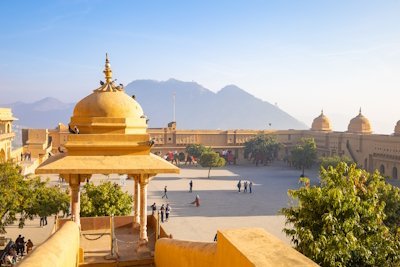India
Hill Forts of Rajasthan
The Hill Forts of Rajasthan are six massive fortifications built in the eclectic Rajput cultural tradition.
They reflect the elaborate, fortified seats of power of Rajput princely states that flourished between the 8th and 18th centuries and their relative political independence. The fortresses protected their palaces, temples and often also had urban settlements within their walls.
Community Perspective: the included forts are Chittorgarh Fort (Clyde), Kumbhalgarh Fort, Ranthambore Fort (Clyde), Gagron Fort, Amber Fort (the easiest to visit as it is just outside Jaipur - Els, Clyde, Nan, Joel), and Jaisalmer Fort (Clyde). Jaisalmer Fort may be the “best” because it is still inhabited and it lies in the Thar desert close to the Pakistan border.
Site Info
Official Information
- Full Name
- Hill Forts of Rajasthan (ID: 247)
- Country
- India
- Status
-
Inscribed 2013
Site history
History of Hill Forts of Rajasthan
- 2013: Revision
- Includes former TWHS Chittorgarh Fort (1981)
- 2013: Inscribed
- Inscribed
- 2012: Referred
- 2012: Advisory Body overruled
- Referral instead of "Not inscribed" proposed by ICOMOS
- Type
- Cultural
- Criteria
- ii
- iii
Links
- UNESCO
- whc.unesco.org
- Official
-
- asijaipurcircle.nic.in — Kumbhalgarh Fort
- asijaipurcircle.nic.in — Chittaurgah Fort
- asijaipurcircle.nic.in — Ranthambore Fort
- Related
-
- chittorgarh.com — Chittorgarh Fort
- amberfort.org — Amber Fort
All Links
UNESCO.org
- whc.unesco.org — whc.unesco.org/
Official Website
- asijaipurcircle.nic.in — Kumbhalgarh Fort
- asijaipurcircle.nic.in — Chittaurgah Fort
- asijaipurcircle.nic.in — Ranthambore Fort
- asijaipurcircle.nic.in — Jaisalmer
Related Resources
- chittorgarh.com — Chittorgarh Fort
- amberfort.org — Amber Fort
News Article
- Aug. 13, 2018 hindustantimes.com — Cracks appear in wall of Gagron Fort
- Nov. 18, 2017 outlookindia.com — Protesters Block Tourist Entry To World Heritage Site Chhittorgarh Fort
- March 7, 2017 financialexpress.com — Chittorgarh Fort vandalised; mirrors of Padmini Palace broken
- Oct. 1, 2016 timesofindia.indiatimes.com — Urinals raise a stink around famed Sonar Fort
- July 23, 2016 timesofindia.indiatimes.com — A world heritage site, but no trace of conservation
- Nov. 13, 2015 ndtv.com — National Security Guard Team Disposes Of Over One Tonne Explosives From Rathambore Fort
- Oct. 23, 2015 timesofindia.indiatimes.com — Jhalawar's Gagron Fort gets face-lift to attract tourists
- March 11, 2015 timesofindia.indiatimes.com — Chittorgarh Fort cracks under illegal mining in its vicinity
Community Information
- Community Category
- Secular structure: Military and Fortifications
- Secular structure: Residence
Travel Information
One million visitors or more
Recent Connections
-
Indiana Jones movie
Temple of Doom: "Originally the Amer Fo… -
Foreigner prices
Chittaurgarh Fort: Citizens of India an… -
Built in the 7th century
Chittorgarh, where Chitrangad, also of …
Connections of Hill Forts of Rajasthan
- Trivia
-
-
One million visitors or more
Amber Fort is the most visited tourist spot in the state attracting 2 million sight-seers in 2023-24 / Amber Fort attracts 1.4 million visitors a year (2007)(wiki) -
Cercle events
Jaisalmer Fort, Rajasthan (Innellea)See www.youtube.com
-
- History
-
-
Mughal Empire
"The Kachchwaha Rajputs of Amber in contrast, aligned themselves with the Imperial Mughal rule with an evident adaptation of Mughal spaces and architectural styles in Amber" (AB ev)
-
- Ecology
-
-
Tiger habitat
Ranthambore: fort within a landscape of forests with aquatic vegetation, which is the habitat of the Indian Tiger (AB ev)
-
- Architecture
-
-
Chahar Bagh Gardens
Amber Palace "The garden, located between the Jai Mandir on the east and the Sukh Niwas on the west, both built on high platforms in the third courtyard, was built by Mirza Raja Jai Singh (1623–68). It is patterned on the lines of the Chahar Bagh or Mughal Garden. It is in sunken bed, shaped in a hexagonal design. It is laid out with narrow channels lined with marble around a star-shaped pool with a fountain at the centre."See en.wikipedia.org
-
Muqarnas
Amber Fort -
Indo-Islamic architecture
Amber - Built in 1592 by a Rajput commander of the army of the Mughal emperor Akbar the fort/palace contains a mixture of Indian and Mughal architectural styles.
-
- World Heritage Process
-
-
Derived from more than one TWHS
Chittorgarh Fort and Hill Forts of Rajasthan
-
- Religion and Belief
-
-
Jainism
Jaisalmer, Ranthambore, Kumbhalgarh (Bawan Devi Temple) and Chittorgarh.
-
- Human Activity
-
-
Hunting Lodge or Castle
Ranthambore Fort (AB ev) -
Royal Hunting Grounds
Ranthambore Fort - the Jaipur Rajput Maharaja's former hunting grounds (AB ev)
-
- Constructions
- WHS on Other Lists
-
-
Cultural WHS set within an IUCN recognised protected area
Ranthambore NP (IUCN cat II), named for the historic Ranthambhore fortress, which lies within the national park (wiki) -
World Monuments Watch (past)
Jaisalmer Fort (1996, 1998, 2000)
-
- Timeline
-
-
Built in the 7th century
Chittorgarh, where Chitrangad, also of the Maurya dynasty, erected a stronghold in the 7th century (AB ev), rest dates from between 8th and 16th centuries
-
- Visiting conditions
-
-
Foreigner prices
Chittaurgarh Fort: Citizens of India and visitors of SAARC (Bangladesh, Nepal, Bhutan, Sri Lanka, Pakistan, Maldives and Afghanistan) and BIMSTEC Countries (Bangladesh, Nepal, Bhutan, Sri Lanka, Thailand and Myanmar) - Rs.15 per head. Others: Rs. 200/- per headSee asi.nic.in
-
- Literature & Film
-
-
Indiana Jones movie
Temple of Doom: "Originally the Amer Fort Jaipur, India was considered for Pankot Palace. However, as permission to film in India was not granted, production moved to Sri Lanka and the palace was created using a Matte Painting."
-
News
- hindustantimes.com 08/13/2018
- Cracks appear in wall of Gagron Fo…
- outlookindia.com 11/18/2017
- Protesters Block Tourist Entry To …
- financialexpress.com 03/07/2017
- Chittorgarh Fort vandalised; mirro…
Recent Visitors
Visitors of Hill Forts of Rajasthan
- AC
- Afshin Iranpour
- Alberto Rodriguez Gutierrez
- Alexander Barabanov
- Alexander Lehmann
- Alexander Parsons
- Alex Marcean
- AlexSchedel
- Alikander99
- Ali Zingstra
- Allegrazwindow
- A. Mehmet Haksever
- Ammon Watkins
- AmyAbroad
- Angela Vandyck
- Anna Wludarska
- Artur Anuszewski
- ashombob
- Aspasia
- Atila Ege
- Bamse
- Bernard Joseph Esposo Guerrero
- Bill Maurmann
- Bin
- BMuramatsu
- Boj
- Brendan Carroll
- campmany
- Carlo Medina
- Carlo Sarion
- Chalamphol Therakul
- Chantal den Haan
- Cheryl
- Chinmaya
- Chole Ross
- Christravelblog
- Claire Bradshaw
- Clyde
- Corinne Vail
- Cyberczar
- Daniel Gabi
- Danny L
- David Marton
- Dimitar Krastev
- DouglasR
- Elis
- Elisabeth Fransisca Situmorang
- Els Slots
- Erfe91
- Erik Jelinek
- Fan Yibo
- Felicité
- Filip Murlak
- Frederik Dawson
- Garrett
- Geert Luiken
- George Gdanski
- GerhardM
- giulio25
- Hadrianus
- HaraldOest
- Harald T.
- Harry Mitsidis
- H Beswick
- Hdhuntphotography
- Iain Jackson
- Ivan Rucek
- Jacob Choi
- Jacob Otten
- Jakubmarin
- janis
- Janos
- Jan-Willem
- Jarek Pokrzywnicki
- Javier
- Javier Coro
- Jean Lecaillon
- Jeanne OGrady
- Jeffrey Chai
- Jezza
- J_neveryes
- Joel on the Road
- John Smaranda
- jonathanfr
- Jon Opol
- Joyce van Soest
- jxrocky
- Karito Vies
- KateY
- KeithBailey
- Ken DJ
- Kevin McFarland
- kiank37
- Knut
- ko9757
- Krijn
- Kurt Lauer
- La Concy
- Lado Joel
- Lameduck99
- Lara Adler
- LaVale
- Lembu
- Liamps91
- lichia
- Linz
- Little Lauren Travels
- Loic Pedras
- Lucio
- Ludvan
- Luis Filipe Gaspar
- Lukasz Palczewski
- Luke LOU
- Maciej Gil
- Maciej Gowin
- Malgorzata Kopczynska
- marcel staron
- MarcoB_0
- Martin
- Martina Rúčková
- Marton Kemeny
- maryhattie
- Matthewsharris
- MaYumin
- mg:1
- Michael Novins
- Michael Turtle
- Mikko
- Miloš Tašković
- Mkandasa
- MMM
- Monica Tasciotti
- MoPython
- Morodhi
- Naim Y
- nan
- Neil McPaul
- Niall Sclater
- Nihal Ege
- Olli-Pekka Turunen
- PabloNorte
- Patrik
- Paul Schofield
- peacemaker2142
- Peltzi
- Petteri
- Philipp Leu
- Philipp Peterer
- phillipmeng
- Pieter Dijkshoorn
- Pink Bunny
- Potsdamer
- Priyaranjan Mohapatra
- RainbowMarbles
- Ralf Regele
- Randi Thomsen
- Reisedachs
- Reza
- Riccardo Quaranta
- Rick Ohm
- Rob Wilson
- Roman Bruehwiler
- S. Anril Tiatco
- Sergio Arjona
- Shandos Cleaver
- Simonf
- Slavi
- Solivagant
- Sorel Americo
- Stanislaw Warwas
- Sutul
- Svein Elias
- Szabolcs Mosonyi
- Szucs Tamas
- Tamara Ratz
- Tammy Gouldstone
- Taotao Chen
- Tarquinio_Superbo
- Tevity
- Thanneermalai L
- TheTravelingRanger
- Thomas Buechler
- Thomas van der Walt
- Tim Allen
- TimPick
- tony0001
- Tony H.
- Truls Brekke
- Vernon Prieto
- Vincent Cheung
- V&M
- voyager
- Waxwing
- Wieland
- Wojciech Fedoruk
- Wo_ko
- Xiquinho Silva
- Yongcheng Liu
- Zoë Sheng
- Zos M
- ZZSong
Community Reviews
Show full reviews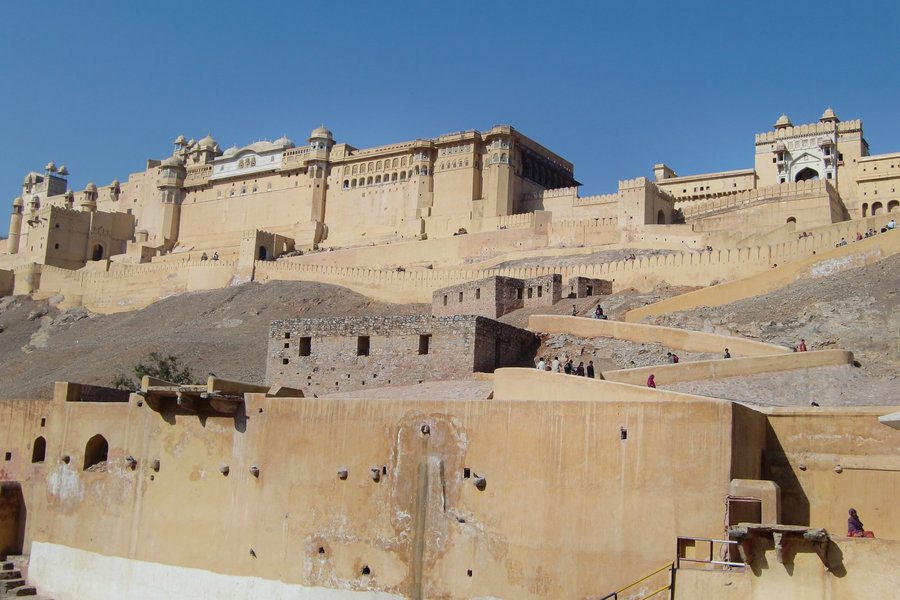
Although this site covers six different forts, we were a bit short on time and opted for the easiest one to visit the Amber Fort just outside of Jaipur. It's pretty easy to access, though I'd recommend using a ride-hailing service like Uber or Ola instead of organising a car through your hotel.
The Amber Fort is really more of a palace than a fort, though it certainly serves that purpose as well. There are multiple terraces and courtyards inside, each leading to an earlier and more exclusive part of the fort. There's fantastic details here at every turn, with impressive sizes matched against exquisite Mughal detailing.
Sadly, elephant rides are still available here as an option instead of climbing up several ramps and staircases to enter the fort. It's not a long or arduous climb, though the heat and hawkers can make for a less-than-pleasant experience.
As with every other site run by the Archaeological Survey of India (which covers most World Heritage sites), you can buy tickets directly online from the dubiously-named but actually legitimate https://asi.payumoney.com. You can then show tickets on your phone to the gate inspectors.
All up, we really enjoyed our visit to the Amer Fort. It's a large enough site that aside from a couple of areas it never really feels all that crowded, and there's a whole lot of fascinating stuff to see. Well worth a half-day of exploring at the very least.
Keep reading 0 comments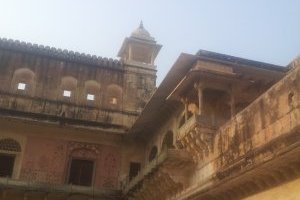
The bus from Jaipur dropped me off near the entry to Amer Fort at the bottom of the hill. The entry lies next to a lake and the view of the Fort with the lake is very scenic. Amer Fort dates to around 1600 and belongs to the Mughal period with major Rajput influences. On the inside it's more of a palace than a fort.
After finishing my visit of Amer Fort, I continued on to the top of the hill. There a second fort is located, Jaigarh Fort. At the time of my visit they were shooting a movie, so I only got to see parts of it. I still got to pay in full. And maybe I am now staring in a Bollywood movie.
Getting There
I only visited the Amer Fort, probably the easiest option of the serial nomination. I flew into Jaipur from Bangalore. India has plenty of budget airlines, so you should consider this option.
After two nights I traveled on by train to Agra. The train running between Jaipur and Agra is newer than the average Indian train and a lot faster.
From Jaipur you can take a local bus to Amer. Amer used to be an independent city, but is now a suburb of Jaipur. My way back to Jaipur was a bit complicated, though, as there were no busses running for an hour or so. And when a bus finally showed up it was fully …
Keep reading 0 comments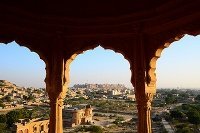
I visited 4 sites of this WHS in December 2011-January 2012. There are several forts in Rajasthan but the ones inscribed in this WHS are really unique. My personal favourite is Jaisalmer Fort in the Thar Desert close to the Pakistan border. It is special because it is still inhabited and the people there are really special. Hopefully sanitation problems and refuse collection will improve thanks to UNESCO but I really hope that the rumours of Jaisalmer becoming a "tourist attraction" meaning that the locals would be "accommodated" in apartments "outside" the city walls does not materialise (similar to what has happened in Bagan, Burma or Angkor Wat, Siem Reap). Jaisalmer Fort is special and unique to me because it is still inhabited after hundreds or thousands of years. I also visited Amber Fort outside Jaipur (entering the fort gate on a painted elephant like a maharajah), Ranthambore Fort, and Chittorgarh Fort with the claustrophobic Victory Tower.
Keep reading 0 comments
It would be fair to include such a WHS. I think it would deserve the WHS status at least as much as the Belfries of France and Belgium. Jaisalmer Fort and Jodhpur's Fort definitely would be 2 highlights in such a WHS.
Keep reading 0 comments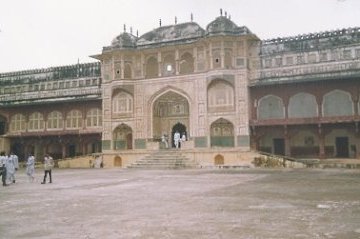
In 1993 I visited one of these forts: Amber Fort. It was my first trip to India, and I was completely overwhelmed by its street life and visible poverty. Jaipur, the nearest city to Amber Fort, also was the first place we visited on our tour.
The Fort is located on the top of a hill, and we walked there in the late afternoon. I remember that it was getting dark when we returned and that there were lots of local kids yelling at us, walking with us, or wanting to hold hands.
The fort was built from 1592 and "shows the evolution from the purely defensive fort settlements of the early medieval period to the palace fortress type of architecture typified in the 16th century." It is quite an extensive complex, with several courtyards, gardens, a temple, audience halls and living quarters.
My visit was so long ago that I cannot really argue if this is a viable WHS or not. But certainly "palaces" in general are still a very prominent feature of Indian history and culture.
Keep reading 0 comments
